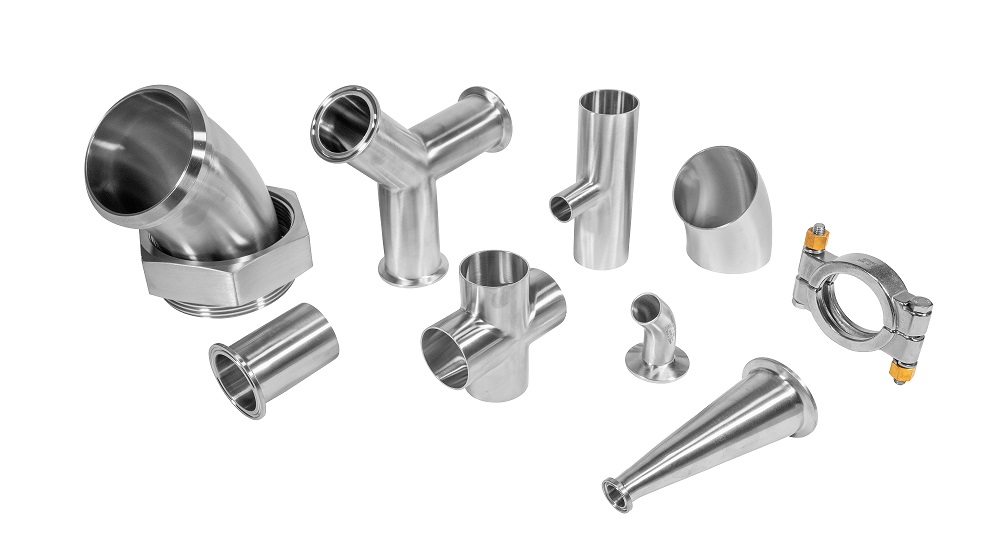Sanitary fittings are the backbone of hygienic processing systems used in industries such as food and beverage, dairy, pharmaceutical, biotech, and cosmetic manufacturing. These fittings are engineered to maintain cleanability, reduce contamination risk, and support regulatory compliance in mission-critical fluid transfer processes.
Unlike standard plumbing components, sanitary fittings are designed to meet stringent cleanliness standards, withstand harsh CIP/SIP cycles, and prevent bacterial harborage. This guide outlines the different types of sanitary fittings commonly used in hygienic systems, their functions, and what makes them essential for commercial and industrial applications.
What Are Sanitary Fittings?
Sanitary fittings refer to the specialized connection components used in processing lines where product purity is non-negotiable. These fittings are typically made from 304 or 316L stainless steel, featuring smooth internal surfaces, crevice-free designs, and high corrosion resistance.
They are compliant with standards like 3-A Sanitary Standards, ASME BPE, and FDA regulations, making them suitable for industries requiring ultra-clean environments. Whether it’s transferring milk, beer, or biologics, these components ensure that no residue or contaminants compromise product safety.
Steel & O’Brien manufactures all core sanitary connection types, with options for standard and custom configurations in both 304 and 316L stainless steel. Surface finishes are available as low as 15 Ra with electropolishing, meeting the demands of high-purity systems.
Types of Sanitary Fittings
Here are the most widely used types of sanitary fittings found in hygienic piping systems:
Tri-Clamp Fittings
Also known as tri-clover fittings, these are among the most common connection types. They use a clamp, ferrule, and gasket to create a secure, leak-proof seal between two pipes or components. They’re ideal for applications requiring frequent disassembly and cleaning.
Explore Steel & O’Brien’s sanitary fittings catalog, including tri-clamp options. S&O offers a wide range of tri-clamp fittings all built to 3-A standards. Quick-ship capabilities ensure same-day delivery for high-demand components.
Sanitary Elbows, Tees & Crosses
Used to redirect or split flow, these welded or clamped components maintain smooth internal paths to minimize turbulence and prevent bacterial growth.
Steel & O’Brien provides both 90° and 45° elbows in polished and unpolished finishes, with options for short-radius and long-radius bends. Tees and crosses are available in reducing and non-reducing styles to suit a variety of processing layouts.
Sanitary Clamps & Gaskets
These support the integrity of hygienic joints. Gaskets are available in EPDM, PTFE, silicone, and Viton®, depending on chemical compatibility and temperature requirements.
All clamps and gaskets from S&O are precision-engineered for compatibility across tri-clamp and tube fitting lines. Customers can select standard or heavy-duty clamps based on pressure rating and line size.
Sanitary Valves
Flow control is critical in hygienic systems. Common options include:
- Ball valves (on/off control with low pressure drop)
- Butterfly valves (economical for large line sizes)
- Diaphragm valves (ideal for aseptic applications)
Valves come in both manual and actuated versions and must support clean-in-place (CIP) or steam-in-place (SIP) protocols.
S&O’s sanitary valves include clamp-end and butt-weld options, with configurations suitable for food-grade and pharmaceutical lines. Three-piece ball valve assemblies are popular for ease of maintenance and CIP compatibility.
Reducers, Ferrules, and Adapters
These fittings adjust the diameter of pipelines, connect dissimilar components, or provide access points for instrumentation, playing a key role in system flexibility and modularity.
Steel & O’Brien offers concentric and eccentric reducers, hose barb adapters, and BPE ferrules for integration into bioprocess lines. Custom ferrules can be machined to fit OEM system requirements.
Hose Barb Fittings & End Caps
Used at line terminations or for attaching flexible hoses in systems where mobility or frequent changeover is needed.
These components fall under broader categories such as sanitary pipe fittings, sanitary tube fittings, and sanitary connection types, each engineered for specific performance standards.
S&O stocks a full line of hose barb fittings in clamp, bevel seat, and male NPT styles. End caps are available with solid, bored, or threaded configurations.
Sanitary Valves & Flow Control Components
Sanitary valves not only regulate flow but also help isolate equipment for cleaning, sampling, or maintenance. Choosing the right valve type depends on:
- Media characteristics (viscosity, solids content)
- Pressure and temperature ratings
- Aseptic requirements
- Cleaning protocols (CIP/SIP compatibility)
For example, diaphragm valves are often used in biotech and pharmaceutical systems where zero dead-leg and full drainability are essential. Sanitary ball valves, in contrast, offer robust shutoff in breweries and chemical processing applications.
S&O also offers valve assemblies with pneumatic or electric actuation, suitable for automated process lines in critical applications.
Industries That Rely on Sanitary Fittings
Sanitary fittings are foundational across many high-purity sectors:
- Food & Beverage: Used in bottling, brewing, dairy processing, and flavor blending. Must comply with 3-A and FDA standards.
- Pharmaceutical & Biotech: Demanding aseptic conditions require fittings that support SIP, validated cleanability, and precise tolerances.
- Dairy Processing: Requires fittings that can handle CIP systems and are built to withstand daily chemical sanitation.
- Cosmetics & Personal Care: Systems need fittings that maintain purity while processing high-viscosity or shear-sensitive products.
In each case, hygienic fittings reduce contamination risks, simplify cleaning, and ensure long-term integrity in complex production environments.
Steel & O’Brien supports these industries with over 10,000 SKUs in stock and the ability to fabricate specialized components for validated systems, including ASME BPE fittings and polished spool assemblies.
How to Choose the Right Sanitary Fittings
When evaluating sanitary ware products for industrial systems, consider the following:
- Material Compatibility: Choose 316L stainless steel for corrosive or sensitive applications.
- Fitting Type: Clamp connections for ease of cleaning; welded for permanent installations.
- Standards Compliance: Look for 3-A, ASME BPE, or EHEDG-certified components.
- Pressure/Temperature Ratings: Ensure ratings match your system’s operational conditions.
- Cleanability: Opt for components with smooth bore finishes (Ra < 20 µin) and minimal dead zones.
Steel & O’Brien’s catalog includes components that meet the most rigorous compliance and performance standards in the market. S&O provides full documentation for material traceability, electropolish certification, and surface finish verification upon request—key for regulated industries.
Conclusion
Understanding the sanitary fitting types available—and their roles in process hygiene, safety, and efficiency—is critical for engineers, OEMs, and plant managers in regulated industries.
From tri-clamp fittings to sanitary valves and hygienic reducers, each component must be chosen for durability, compliance, and cleanability. Steel & O’Brien combines deep inventory with fast turnaround times and in-house manufacturing to support both standard and specialized system needs.
For a complete line of sanitary-grade components built for performance in demanding environments, visit Steel & O’Brien’s full selection of sanitary fittings.

